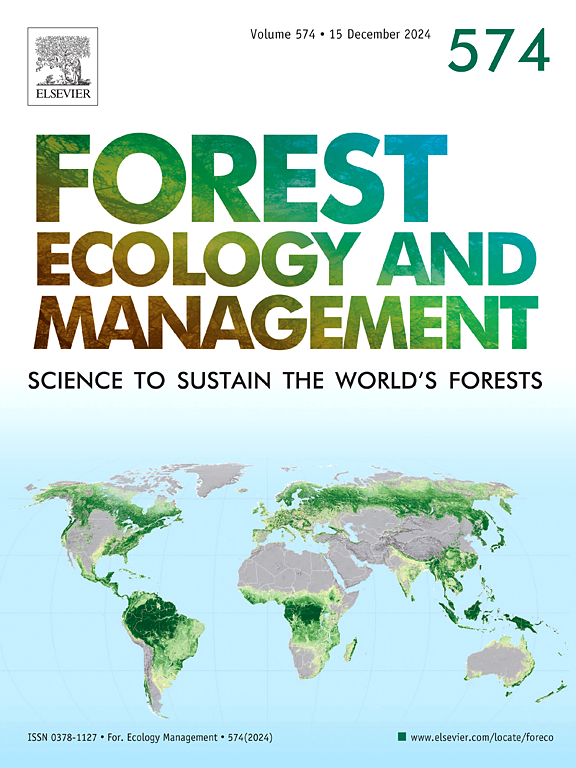单独施肥并不能保证糖枫再生的成功
IF 3.7
2区 农林科学
Q1 FORESTRY
引用次数: 0
摘要
糖枫(SM;槭(Acer saccharum Marshall)在北美东北部被认为具有很高的经济和生态价值。在过去的几十年里,枯死和再生失败对其可持续性构成了威胁,特别是在酸性和碱性贫乏的土壤中。研究了曲海北部阔叶林在石灰处理20年后的低更新和优势更新状况。石灰从根本上增加了该层的低再生密度和SM比例,最高剂量可达到对照样地的7倍以上。优势再生只有4 %的SM(均在石灰样地),而85 %的美洲山毛榉(AB;大叶Fagus grandfolia Ehrh.)。石灰处理对优势再生体的组成无显著影响,对SM和AB再生体的直径和高度无影响或负影响。这可能是由于石灰施用导致的更高的再生密度和冠层闭合对光和养分的竞争。结果表明,在酸性和碱性较差的北方阔叶树林分施用石灰20年后,单次添加石灰可提高再生后期SM的比例。但是,必须考虑造林处理,以确保SM较低的更新达到林分中较高级的层。本文章由计算机程序翻译,如有差异,请以英文原文为准。
Liming alone does not guarantee the success of sugar maple regeneration
Sugar maple (SM; Acer saccharum Marshall) is considered to have a high economical and ecological value in northeastern North America. Over the last few decades, dieback and regeneration failure have posed a threat to its sustainability, particularly in acidic and base-poor soils. We evaluated the status of lower regeneration and dominant regeneration in a base-poor northern hardwood stand in Québec, 20 years after a liming treatment. Liming radically increased the density of lower regeneration and the proportion of SM in this stratum, up to levels more than 7 times those of control plots for the highest doses. Dominant regeneration consisted of only 4 % SM (all in the limed plots), while 85 % was American beech (AB; Fagus grandifolia Ehrh.). However, liming had no statistically significant effect on the composition of dominant regeneration, and no effect or a negative effect on the diameter and height of SM and AB regeneration. This can probably be explained by competition for light and nutrients resulting from a greater regeneration density and canopy closure in response to lime application. Results show that 20 years after its application in an acidic and base-poor northern hardwood stand, a single lime addition can contribute to increasing the proportion of SM at the lower regeneration stage. However, sylvicultural treatments must be considered to ensure that SM lower regeneration reaches a more advanced stratum in the stand.
求助全文
通过发布文献求助,成功后即可免费获取论文全文。
去求助
来源期刊

Forest Ecology and Management
农林科学-林学
CiteScore
7.50
自引率
10.80%
发文量
665
审稿时长
39 days
期刊介绍:
Forest Ecology and Management publishes scientific articles linking forest ecology with forest management, focusing on the application of biological, ecological and social knowledge to the management and conservation of plantations and natural forests. The scope of the journal includes all forest ecosystems of the world.
A peer-review process ensures the quality and international interest of the manuscripts accepted for publication. The journal encourages communication between scientists in disparate fields who share a common interest in ecology and forest management, bridging the gap between research workers and forest managers.
We encourage submission of papers that will have the strongest interest and value to the Journal''s international readership. Some key features of papers with strong interest include:
1. Clear connections between the ecology and management of forests;
2. Novel ideas or approaches to important challenges in forest ecology and management;
3. Studies that address a population of interest beyond the scale of single research sites, Three key points in the design of forest experiments, Forest Ecology and Management 255 (2008) 2022-2023);
4. Review Articles on timely, important topics. Authors are welcome to contact one of the editors to discuss the suitability of a potential review manuscript.
The Journal encourages proposals for special issues examining important areas of forest ecology and management. Potential guest editors should contact any of the Editors to begin discussions about topics, potential papers, and other details.
 求助内容:
求助内容: 应助结果提醒方式:
应助结果提醒方式:


